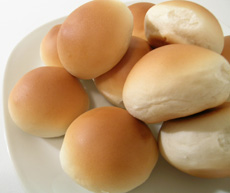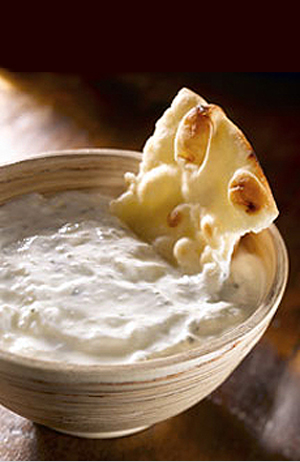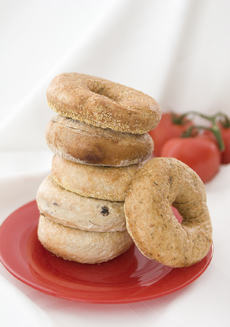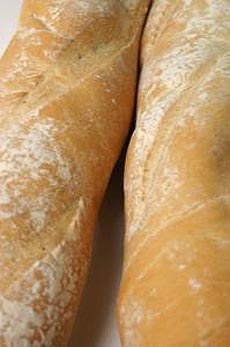Bread is one of the oldest prepared foods (foods that
do not grow naturally but require preparation). Man had discovered that adding
water to the grain—i.e., creating porridge—made it more palatable.
Further experimentation led to cooking the mixture
on stones that had been heated in a fire, creating the first breads,
which were flat and tortilla-like.
Using wild yeast to make it rise, cooking it on hot stones evolved to closed
ovens made of brick or clay, fueled by charcoal reaching temperatures of up to 480°F, bread evolved into different types.
The ancient Greeks turned bread baking into an art.
They invented the front-loaded bread oven and a wide variety of doughs,
loaf shapes and styles of bread to pair with specific foods.
The Romans invented the concept of grinding grain
by rubbing it between two stones.
White bread, was also invented by the Romans.
Comfort food: warm naan with a yogurt dip
(photo from Stonefire)
Naan is typically brushed with butter or ghee (clarified butter) and served hot as a table bread, where it’s used to scoop other foods.
But naan has become a world
traveler. You can serve it with any cuisine, and use it instead of
other signature breads with just about any food. For example:
- Sandwich-style, it is often rolled and stuffed, wrap-like. In India, popular fillings include minced meat or potatoes and onions. Here, anything goes.
- As a pizza base, just pile on the toppings (scroll down for the chicken pesto pizza and the raspberry-Nutella dessert pizza).
- In recipes galore on the website, from appetizers to mains and sides.
A stack of Bake ’mmm bagels, hot from the oven.
Photo by Saidi Granados.
You can make the bagels:
- In The Oven: Bake them in a convection, electric, gas or toaster oven per the instructions on the box.
- In A Toaster: Defrost bagels in the microwave or in the refrigerator overnight, slice and toast.
BAGUETTE
Baguettes. Photo by Aniko Gaspar | SXC.
A long, narrow loaf with a very crusty, amber-colored outside and a delicate, tender inside. In France and elsewhere, it is used as a multipurpose bread, including for sandwiches; slices are used as the base for canapés. The name means “a small rod” in French.
While it is closely identified with France, the prototype was developed in Vienna in the mid-19th century, when the first steam ovens made possible the crisp crust and the porous (with holes) white crumb.

BUN
Hamburger buns. Photo by J. Eltovski | Morguefile
A small bun with a variety of meanings, from a sweet roll to a pastry (hot cross bun, raisin bun) to a specialty bread for hamburgers and hot dogs.
Em inglês, o pão francês seria chamado de roll (porque a massa de pão é enrolada antes de ser assada). Um pão de forma é um loaf e uma fatia de pão é slice. Um pão de forma fatiado, portanto, é um sliced loaf. Um pão de hambúrguer (em inglês, hamburger. Note: sem “u” após o “g”) é um bun.
Então, na próxima viagem, bye bye bread! Use:
- loaf = pão de forma
- slice = fatia
- sliced loaf = pão de forma fatiado
- bun = pão de hambúrguer
- roll = pãozinho francês
- soft roll = pão de cachorro-quente
- small roll = bisnaguinha




Nenhum comentário:
Postar um comentário